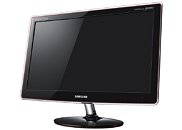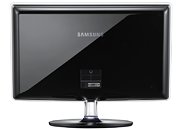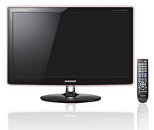Saturday, May 9th 2009

Samsung Introduces New Slim Touch of Color LCD Monitors
Samsung Electronics America, a subsidiary of Samsung Electronics Corporation, the number one worldwide brand of LCD display products, today announced the release of its 70 Series Monitors: the P2070, P2370 and P2370HD. These slim LCD monitors, with screen depths of 30 mm (1.18 inches) for the P2070 and P2370 and 65.5mm (2.58 inches) for the P2370HD and Touch of Color (ToC) design, are the latest release of Samsung's high performance displays.
"The 70 Series offers our customers a sophisticated-looking LCD monitor with the performance capability of our televisions," said J.H. Kim, President of Samsung Electronics America's Information Technology Division. "The 70 Series is the new standard as more people upgrade their monitors for additional uses, like watching television programs and playing video games."The 70 Series Monitors are ideal for office applications and entertainment with its dynamic contrast ratio (50,000:1) for deep, rich colors, while the 2ms (GTG) video response time minimizes blurring for watching sports and fast-moving gameplay. The crystal-like bezel frame with ToC reduces the reflection of light and glare. The glossy stand offers a polished design, while the clear, crystal-like acrylic neck gives the illusion the monitor is floating.
Samsung's Startlight Touch Controls integrate the On Screen Display (OSD) buttons into the bezel for a seamless look and feel, eliminating obtrusive buttons on the front or sides on the panel. Gently touching any of the buttons illuminates the controls which automatically disappear after a set period of time, minimizing distractions.
The P2370 offers full HD 1080p resolution (1920x1080) for optimized viewing of HD content. For full HDTV capability, the P2370HD builds on the 1080p capabilities of the P2370 with the addition of a HDTV tuner, integrated speakers with SRS TruSurround HD(r) and remote control. In addition, the P2370HD also has HDMI and component inputs for additional connections such as Blu-Ray, set-top boxes and game consoles providing users with a display that is ready for work and play.
"The 70 Series is a great monitor for someone looking a full range of color, sharpness and response. It also has an added benefit for those concerned about the environment. We were sensitive to the impact computers monitors have on the environment and have developed a manufacturing process for the 70 Series that would minimize this," said Tony Yu, Display Product Manager of Samsung Electronics America's Information Technology Division.
The 70 Series offers a suite of eco-conscious features including reduced energy consumption, requiring about a third less power to operate compared to typical monitors of similar size. The ToC manufacturing process eliminates harmful paints and sprays, increasing the monitors' recyclability. The slim footprint also dramatically reduces transportation costs and requirements for a smaller carbon footprint.
P2070 \ P2370 \ P2370HD LCD Monitors
Source:
BusinessWire
"The 70 Series offers our customers a sophisticated-looking LCD monitor with the performance capability of our televisions," said J.H. Kim, President of Samsung Electronics America's Information Technology Division. "The 70 Series is the new standard as more people upgrade their monitors for additional uses, like watching television programs and playing video games."The 70 Series Monitors are ideal for office applications and entertainment with its dynamic contrast ratio (50,000:1) for deep, rich colors, while the 2ms (GTG) video response time minimizes blurring for watching sports and fast-moving gameplay. The crystal-like bezel frame with ToC reduces the reflection of light and glare. The glossy stand offers a polished design, while the clear, crystal-like acrylic neck gives the illusion the monitor is floating.
Samsung's Startlight Touch Controls integrate the On Screen Display (OSD) buttons into the bezel for a seamless look and feel, eliminating obtrusive buttons on the front or sides on the panel. Gently touching any of the buttons illuminates the controls which automatically disappear after a set period of time, minimizing distractions.
The P2370 offers full HD 1080p resolution (1920x1080) for optimized viewing of HD content. For full HDTV capability, the P2370HD builds on the 1080p capabilities of the P2370 with the addition of a HDTV tuner, integrated speakers with SRS TruSurround HD(r) and remote control. In addition, the P2370HD also has HDMI and component inputs for additional connections such as Blu-Ray, set-top boxes and game consoles providing users with a display that is ready for work and play.
"The 70 Series is a great monitor for someone looking a full range of color, sharpness and response. It also has an added benefit for those concerned about the environment. We were sensitive to the impact computers monitors have on the environment and have developed a manufacturing process for the 70 Series that would minimize this," said Tony Yu, Display Product Manager of Samsung Electronics America's Information Technology Division.
The 70 Series offers a suite of eco-conscious features including reduced energy consumption, requiring about a third less power to operate compared to typical monitors of similar size. The ToC manufacturing process eliminates harmful paints and sprays, increasing the monitors' recyclability. The slim footprint also dramatically reduces transportation costs and requirements for a smaller carbon footprint.
P2070 \ P2370 \ P2370HD LCD Monitors
- Thin 30 mm screen depth (65.5 mm - P2370HD)
- High contrast ratio of 50,000:1
- Full HD 1080p (1920x1080) resolution (1600x900 - P2070)
- Fast 2ms (GTG) video response time (5 ms - P2370HD)
- Reduced power consumption
- Touch of Color (ToC) technology
- VOC-free Crystal-like bezel frame to help reduce glare
- Starlight Touch Controls
- Built-in 1080p digital HDTV tuner; 5 ms (GTG) video response time and HDMI input (P2370HD)



41 Comments on Samsung Introduces New Slim Touch of Color LCD Monitors
Why did samsung make the back of the screen glossy? it's not like anyones gonna look at the rear....
but a nice design though...
Let me try that again:
16:10 > 16:9 IF
16:10 = 1920x1080 and 16:9 = 1920x1080
But
16:9 > 16:10 IF
16:10 = 1920x1080 and 16:9 = 2048x1152
"But 1200p > 1152p" is what a noob would say.
It's simple math folks.
1920x1080 = 2073600
1920x1200 = 2304000
2048x1152 = 2359296
As you can see, a 2048x1152 (16:9) resolution has 55296 more pixels than a 1920x1200 (16:10).
"Where the heck did you pull out the '2048x1152' from?" is what another noob would say.
Clickity
Of course, if you bring a 30" Monitor with a 2560x1600 resolution, than it'd be a different story. Because a 30" Monitor with a 16:9 resolution buffed up to those lines would also kill it.
It doesn't require a genious to know this.
And as related to something else .265 isn't used in very many movies. There are 3 standard variations of widescreen, w/ most falling in between 16:9 and .265:1.
16:10 is always > 16:9 when the horizontal resolutions are the same.
It doesn't require a genius to know this.
With your logic, why don't we keep using 4:3 monitors while we're at it?
And you can keep your facepalms and smart ass "genius" comments to yourself, thank you.
According to you, as long as the horizontal resolutions are the same, 16:10 > 16:9, which in reality is true, but why do you think we've been going "wide" for the past couple of decades?
2048xx1536 (4:3) > 2048x1280 (16:10) > 2048x1152 (16:9)
A 4:3 with that resolution can support 1080p videos any day of the week. The problem is how WILL the 1080p video look in there. HUGE ANNOYING black sides on top and bottom of the monitor. Bluray movies are NEVER released in a 16:10 ratio, it's either Widescreen (16:9) or Ultra-Widescreen (21:9), or 4:3 if they're from the 80's.
Put simply, 16:10 should have never existed in the first place. As someone mentioned above, only reason we even got to see them is because it was cheaper for manufacturers to make them.
Put even simpler, wider = better (for Monitors and TVs anyways).
And we are talking LCDs here. Show me a 4:3 LCD with those resolutions that doesn't cost 4 digits. The highest you see an LCD in 4:3 is 1600x1200.
You can bet your ass that if a 1920x1440 monitor existed around the same size and price as my current monitor, I would have it. For computer use 1920x1440 is a lot better than both 1920x1200 and 1080.
No, not so great for movies, and I agree, but guess what, computer monitors are used for much more than movies.
This is what both you and Mussels are failing to see. I understand your viewpoint perfectly, I just find it flawed. 4:3 and 16:10 are much more productive for computer uses. 16:9 is not the way to go on a computer, unless it's primary purpose is widescreen movie watching.
But as you can probably tell from my avatar, I watch a lot of animes, as well as tons of videos and movies on my 1920x1200 monitor and I don't appreciate the black bars when watching 720p and 1080p stuff. Though now that you have explained, I understand your point and can't argue with you on that.
Gimme a break! :shadedshu There are far more important things to discuss than arguing like little brats.